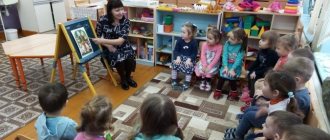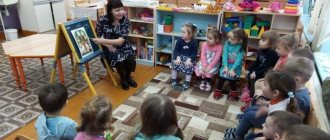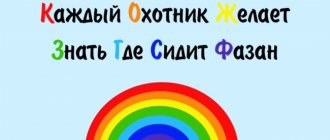Preview:
“Social and communicative development of a young child”
Scenario for any game.
Didactic game for education of morality and development of empathy in children
DIDACTIC GAME “Good or Bad”
Mastering the basic moral norms and values accepted in society.
• Helping the child learn the basic rules of communication with peers and older members of society.
• Formation of independence and decision-making skills in the child.
• Helping the child master the basic emotional components of communication - empathy, responsiveness, mercy.
• Formation in each child of respect for his family, peers, elders and society as a whole.
• Help in developing positive attitudes in the child towards work and creativity.
Cards are green and red (each child has 1 green and 1 red).
Children in any position (standing or sitting on the carpet). Each of them has 2 cards in his hand - one green, the other red). Green is good, red is bad. The teacher names the situation, and the children must pick up a card of one of the colors - green (good) or red (bad).
- Grandmother baked a kolobok when grandfather asked her to. Good or bad? - we ask the children. They shout “good!” and raise a green card.
- Did Little Red Riding Hood talk to the wolf in the forest? Mom told me not to talk to strangers. (Red card)
- The grandfather called his family for help when he could not pull out the turnip. ( Fine )
- Emelya loved to lie on the stove and do nothing. ( Badly )
- The crocodile swallowed the sun. ( Badly )
- Mukha invited guests for tea when she bought a samovar. ( Fine )
- The spider wanted to kill the fly. ( Badly )
- The mosquito saved the fly. (Okay) What kind of mosquito was it? (kind, brave)
- The wolf ate the kids in the fairy tale. ( Badly )
- The girlfriends called the Snow Maiden to the forest to pick berries. And they left without her. ( Badly )
- My parents told my sister to look after my brother, and she ran off with her friends for a walk (Bad) - What is the name of the fairy tale?
- My sister saved my brother. ( Fine )
Notes (if necessary)
- Teachers can make up situations on the go.
- The game helps you remember fairy tales and their plots.
- For each situation, you can ask additional questions (good / bad qualities of the hero, what should have been done / should not have been done, etc.).
8. "Poker"
This fun word game is especially popular with kids. Ask the children to make a wish for any piece of furniture (chair, armchair, etc.) or kitchen utensil (fork, poker, rolling pin, etc.).
Then the driver asks the players various questions, which must be answered only with the hidden word.
Example: What is your name? - Poker.
What did you have for breakfast today? - Poker.
What gift did you receive for your birthday? - Poker.
Another version of the game: players think of words for each other, which they will then use to answer the driver.
Complication: You can't laugh.
On the topic: methodological developments, presentations and notes
Through play, children learn social norms.
The didactic game “Good-bad” for the middle group was developed by teacher Sakara R.N. https://yadi.sk/i/AU-7rdmT336apX.
Goal: to form ideas about the beneficial and harmful properties of fire. Develop logical thinking, memory, attention.
Dtactic game “Good - Bad” for children of primary preschool age.
While playing, learn to distinguish between good and bad actions and explain your choice.
Lotto game “Good or bad?” reproduces several frequently encountered life situations. While playing, we will find out the child’s attitude to such situations and, if necessary, immediately adjust.
What is good and what is bad
The little son came to his father and the little one asked: “What is good?
and what is
bad? -
I have no secrets, - listen, kids, - I’m putting my dad’s answer in the book.
- If the wind tears the roofs, if there is hail, everyone knows that this is bad for walking.
The rain came and went.
The sun in the whole world. This is very good for both adults and children.
If the son is blacker than night, dirt lies on his face, it is clear that this is very bad for the child’s skin.
If a boy likes soap and tooth powder, that boy is very sweet and does well.
If a crappy fighter beats a weak boy, I don’t even want to put that in a book.
This one shouts: “Don’t touch those who are smaller!” This boy is so good, he’s a sight to behold!
If you tear a book and a ball in a row, the Octobrists say: you’re a bad boy.
If a boy loves work and points his finger at a book, they write about him here: he is a good boy.
The little one ran away from the crow, groaning. This boy is just a coward. This is very bad.
This one, although only an inch taller himself, argues with a formidable bird. Brave boy, well, he will be useful in life.
This one got into the mud and is happy. that the shirt is dirty. They say about someone like this: he is bad, a slob.
This one cleans his felt boots and washes his galoshes himself. Although it is small, it is quite good.
Remember this every son. Know any child: a son will grow up to be a pig, if the son is a pig,
The boy went joyfully, and the baby decided: “I will do well,
and I won’t -
it’s bad.”
Well, what do you think of Pakhomov’s illustrations to Mayakovsky’s poem “What is good and what is bad”? Amazing, right? Better than them, perhaps, I have only seen. But there is already something incredible there!



